![]()
THE WORKS OF ARTHUR GERBER-TRANSIT STATIONS
New Addition-Merchadise Mart with Gerber in Picture-see below
MICHIGAN CITY, IN

This photograph captures some of the essence of Gerber's work-a South Shore Line interurban train of the Northern Indiana Commuter Transit District (NICTD) pauses outside Gerber's 1927-vintage Michigan City, IN, station.
According to the July 10, 1998, Michigan City News-Dispatch, on July 8 a group Chicago developers called the South Shore Station Limited Liability Co. purchased the station, according to an article sent by Carl Reed. Apartments are planned for the upstairs level with business use downstairs. The historic front of the building will be retained, along with certain other significant features inside as well. The former baggage area next to the station will be converted into a shop catering to South Shore Line commuters.
Unfortunately, as of November, 2007, there were no obvious signs of rehabilitation work having yet started on the Michigan City station.
This station is shown in the Pentrex videotape "Street Running" (2000 release) in the South Shore segment.
HIGHLAND PARK-RAVINIA & BRIERGATE
RAVINIA
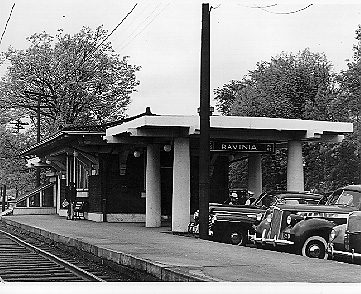
The Ravinia station was located two miles south of downtown Highland Park. This station was north of the better know Ravinia Park station of the interurban which predated Gerber's tenure with the Insull interurbans. These three photos of the Ravinia station are courtesy of the Highland Park Historical Society.
The spring, 2004, issue of First & Fastest contains a view of this station.
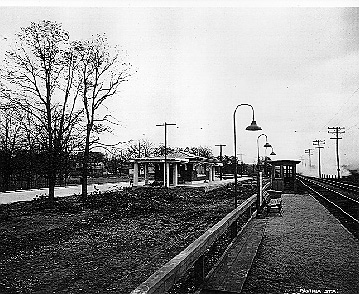
A depressing sight-tracks removed, with the station set to be torn down shortly. This picture dates from around 1955, following abandonment by the North Shore Line of its original, yet slower, Shore Line route, moving all trains instead to the newer and faster Skokie Valley route to west.
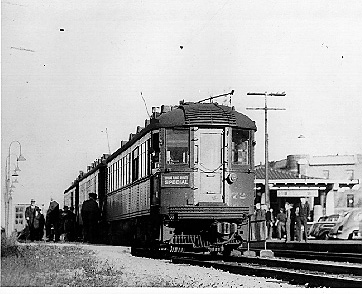
Southbound North Shore Line train drops off and picks up passengers at the Ravinia station before passing through the wealthy suburban communities along the shores of Lake Michigan.
For an interesting pencil and paper rendition of the Ravinia station, see the website of artist Jeffrey Jakucyk.
And across town in Highland Park was the other station...Briergate.
BRIERGATE
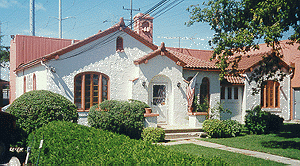
One of the styles that Gerber is best-known for is "Insull Spanish," a Mission Revival look popularized earlier in the Southwest which he employed for six new stations along the North Shore Line's "Skokie Valley Line" in 1926. This new, high-speed line was built by the North Shore Line to bypass the congested suburbs to the east along the original "Shore Line" between Chicago and Milwaukee. A contest was held by the North Shore Line where the public was invited to name these new depots. These charming buildings held the waiting room and ticket office in front with a residence for the station agent and his or her family in back.
Only the Briergate stations still stands today in suburban Highland Park of the original "Insull Spanish" designs on the Skokie Valley line. A restored twin stands in Beverly Shores, IN, along the South Shore Line.
BEVERLY SHORES, IN

Beverly Shores, IN, station as shown following restoration work the following month by NICTD. Note the South Shore Line tracks in the foreground along with the classic neon roof sign. June, 1998.

Beverly Shores, IN, station prior to restoration work. August, 1997.
For additional views of the Beverly Shores station restoration, including work-in-progress interior and exterior shots, check out Louis Van Winkle's fascinating train stations homepage and the section on Beverly Shores.
In 1928 sister interurban to the North Shore Line, the Chicago, South Shore, and South Bend ("South Shore Line") added two stations in Indiana using Gerber's same Insull Spanish design. Only the station at Beverly Shores remains. The building is owned by NICTD while the land actually belongs to the Northern Indiana Public Service Company, or NIPSCO-yet another Insull property at one time. The residence was to the left (north) in the picture above, while the waiting room and ticket window were on the right, next to the platform and track. This building was the residence of South Shore Line station agent Nellie Warren and her husband AJ who worked for the South Shore Line as a motorman.
In local newspaper articles sent by Beverly Shores historian Carl Reed, Gerber's Beverly Shores gem reopened to the public on July 18, 1998, after renovation expenses of approximately a half million dollars by NICTD. On hand for the grand re-opening were US Representative Pete Visclosky, County Commissioner Jim Biggs, NICTD Marketing Manager John Parsons, along with NIPSCO and Beverly Shores representatives. NIPSCO is renewing its original lease on the building to NICTD at the rate of $10 per year! Architect Gerber received mention in The Beacher magazine in extensive articles with pictures covering the happy event. Gerber also received mention in the Michigan City News-Dispatch in relation to this event. The restored station is now used as offices, an art gallery with work from local artists, and a history museum.
VILLA PARK, IL
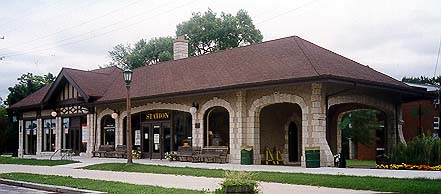
This stunning station today serves as the home of the Villa Park Historical Society Museum and is open to the public. Gerber designed this building for yet another Insull interurban, the Chicago, Aurora, and Elgin. The CA&E ran from Chicago west through Villa Park to Wheaton, where it forked into branches fanning out toward its namesake cities. Passenger service ended in 1958, a victim of the Eisenhower Expressway, with the remaining freight operations gone by 1962. This English Tudor design from 1929 is similar to Gerber's very early work for the Northwestern Elevated Railroad, a predecessor of today's Chicago Transit Authority and the "L," especially his Tudor stations along the Ravenswood "L" line. Another CA&E station, though not designed by Gerber, is also in place just west on Ardmore Avenue in Villa Park. For details on the Villa Avenue depot see the Summer 1990 issue of First & Fastest magazine.
SKOKIE, IL-DEMPSTER STREET STATION
A new section of this website also contains updated photos of the restored station and canopy across the parking lot.
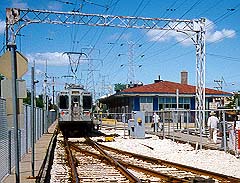
At a March 19, 2001, board meeting the Village of Skokie mayor and trustees voted overwhelmingly to approve a plan by a local developer to move and restore the historic Dempster Street station. The developer is the Taxman Corporation which restored the 4000 square foot Dempster Street station after moving it across the parking lot 135 feet to the east. Architect for the project was Anunovich Associates which renovated the Reliance Building in Chicago. Starbucks moved into the restored station as did a branch bank.
Click here to see pictures of Gerber's Dempster Street station restored after its move.
In 1925 Gerber completed his crowning achievement, the Prairie Style station on Dempster Street in Niles Center (later renamed Skokie), IL. This magnificent structure included terrazzo floors, intricate eaves and bracket work, and strong horizontal lines characteristic of this uniquely Midwestern style. A Gerber touch included the exterior globe lamps. On the morning before its opening the architect's late son, Burton Gerber, recalled seeing his father on a ladder hand polishing the windows.
The Dempster Street Station first served rapid transit trains from the Insull-affiliated Chicago Rapid Transit system (the"L") and the next year trains were added with interuban service from the Insull-controlled North Shore Line. Fast and sleek North Shore Line trains stopped at Dempster Street on their way between Chicago and Milwaukee, using this new bypass. Both the CRT and the North Shore Line drew their power from Insull's Commonwealth Edison company whose wires still are strung over the building today. The North Shore Line used the two tracks in the picture above occupied by a Chicago Transit Authority (CTA) "L" train, stopping on the west side of the building to board passengers. This station helped fuel the growth in Chicago's northern suburbs in the 1920s.
Two years after the North Shore Line was abandoned in 1963 the CTA resumed transit operations from the Howard Street "L" terminal 4.6 miles northwest to Dempster Street in an experimental service soon nicknamed the "Skokie Swift." This experiment became a success and a permanent "L" line now referred to as the CTA "Yellow Line." Passengers board from a new building just south (behind) of this location.
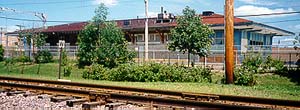
Dempster Street Station, looking east. Tracks in the foreground are of the recently (Spring 2002) abandoned Union Pacific (former C&NW) Skokie Subdivision freight line. The last customer was the Crafty Beaver lumber yard at Oakton St. North of Dempster St. the C&NW swung over onto former North Shore Line tracks which paralled its own freight line. Talk continues about extending L rapid transit service north of Dempster St. to either Old Orchard or Northbrook malls, both of which are near this former North Shore Line Skokie Valley route.
In 2003 grade crossing were removed at several locations along the former C&NW Skokie Subdivision and paved over, including Dempster St.
Sketches of west and east Dempster St. station profiles (c) copyright J.J. Sedelmaier Productions Inc. ("sedelmaier at aol.com"-the word "at" is used in place of @ to reduce spam) and used with permission.
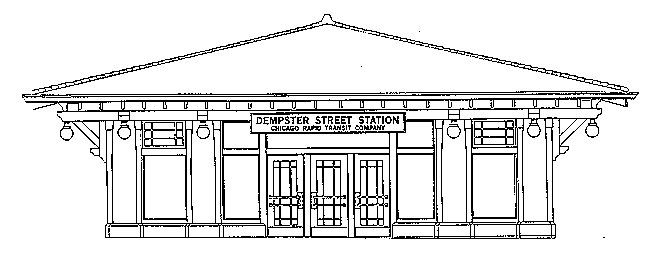

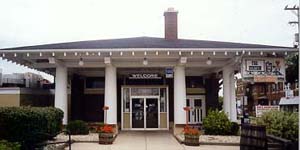
KENOSHA, WI
Gerber built four stations between 1920 and 1925 with the same Prairie School design-Dempster Street (see above) in Skokie, IL, Mundelein, IL, Ravnia St.-Highland Park, IL, and Kenosha, WI. Mundelein and Kenosha stations were sisters of each other, while the Dempster Street station was twice the size of its look-alike siblings. Kenosha is an old manufacturing city just over the Illinois border in Wisconsin. The Mundelein and Ravinia Street stations of the North Shore Line are gone but the Kenosha one survives today (2003) as a planned community center, replacing a restaurant formerly in the building.
WILMETTE, IL-LINDEN AVENUE. Before & After.
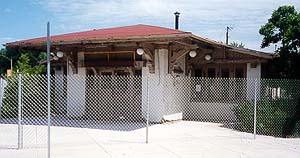
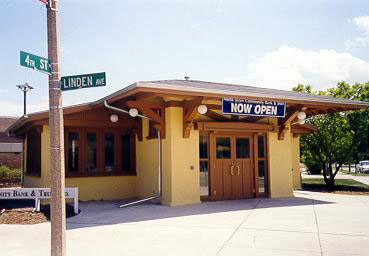
One of Gerber's earliest buildings was this terminal building for the Northwestern Elevated Railroad (CRT/CTA predecessor) which ran electric rapid transit "L" trains from Chicago through Evanston and into Wilmette. Gerber was an employee of the Northwestern Elevated at the time he build this station in 1913 (expanded in 1921). It is a great example of the Bungaloid Style from that period with its heavily bracketed eaves-and Gerber's globe lamps. At the time of this photograph in 1997, a fence was placed around the building to prepare it for renovation into a branch bank.
EVANSTON, IL-SOUTH BLVD.
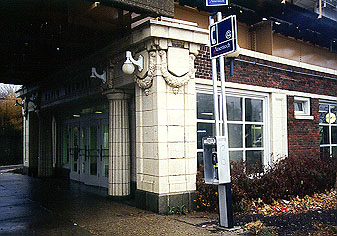
A challenge that Gerber faced in designing new stations along the Chicago Rapid Transit (CRT) line which ran through Chicago's North Side into Evanston and Wilmette was tight space. Gerber was forced to shoehorn functional yet attractive transit stations into narrow spaces beneath the tracks and platforms of the "L" overhead. The South Boulevard station in Evanston is one example of several (Bryn Mawr, Wilson, Howard in Chicago; Central Blvd. and South Blvd. in Evanston) surviving stations where Gerber used an elegant Beaux Arts design which held not only the normal ticketing facilities but also leased retail space which returned revenue to Insull's CRT. These shops sold newspapers, candy, cigarettes, and other similar items to commuters passing through. During the time of construction of these stations in the early and mid-1920s, the Beaux Arts look was much in vogue for new commercial buildings in Chicago.
MILWAUKEE, WI.
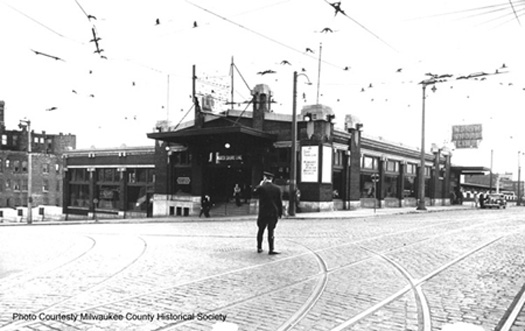
This busy depot at the corner of Michigan and 6th Streets in downtown Milwaukee was built in 1920. In this picture it was serviced not only by the North Shore Line interurbans but also streetcars of The Milwaukee Electric Railway (TMER). This view looks southeast. The Milwaukee station is long gone, replaced by a modern insurance company building on the same location.
UPTOWN, CHICAGO.

This beaux arts station is still there at the northwest intersection of Wilson and Broadway Avenues in Chicago's Uptown neighborhood. Over the decades tacky remodeling and the removal of the ornate section above the entrance have detracted from its original appearance as built in 1923. This photo, like others in my collection, came from the architect's late son, Burton Gerber. Note the sign showing "Arthur Gerber-Architect" in the blow-up inset photo.
Gerber's McJunkin Building is directly across the street from his station, at the southwest corner of Wilson and Broadway.
ASBURY AVE.; EVANSTON, IL
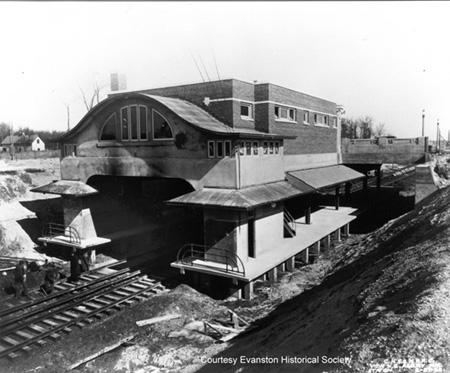
Long-time Evanston resident Gerber designed a series of rapid transit stations which opened in 1925 between Howard Ave. in Chicago and Dempster St. in Niles Center (now Skokie). These stations closed when local service was discontinued by the CRT in the late 1940s. North Shore Line interurbans never used these stations which were for purely local service. This particular example straddled the CRT/CNS&M right-of-way at Asbury Ave. in Evanston, another creative use of space. The station was entered at the upper, street level which hosted a snack shop and ticket office.
MERCHANDISE MART-CHICAGO
 This photo shows Arthur Gerber with a crowd at the 1930 opening of his Merchadise Mart station of the Chicago Rapid Transit (now CTA) . The architect is at the far right in the photograph-cigar in hand! This view shows the interior of the station which served what was then the world's largest building by volume. The exterior of the station still spans Orleans St. which ran below the CRT tracks.
This photo shows Arthur Gerber with a crowd at the 1930 opening of his Merchadise Mart station of the Chicago Rapid Transit (now CTA) . The architect is at the far right in the photograph-cigar in hand! This view shows the interior of the station which served what was then the world's largest building by volume. The exterior of the station still spans Orleans St. which ran below the CRT tracks.
Photo courtesy of the late George Krambles.
![]()